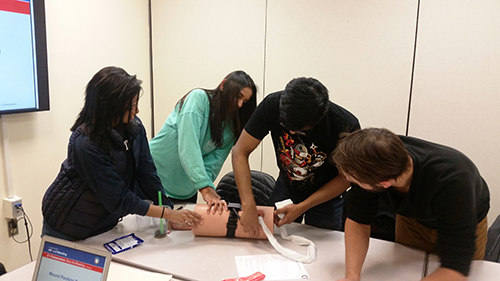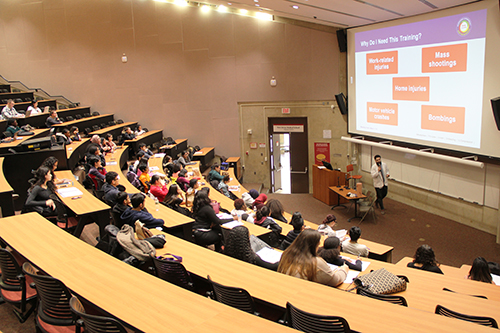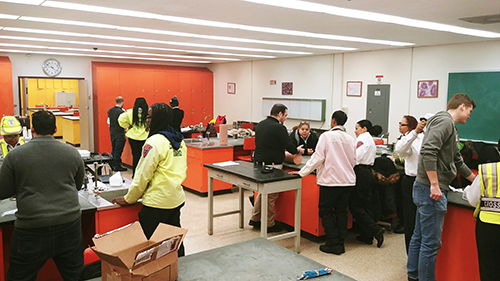NJMS Students Take the Lead on Bleeding Control Community Education
 When a tragic event like a shooting occurs, a bystander on the scene with bleeding control training can mean the difference between life and death for a seriously injured victim before first-responders arrive. And while there’s a good chance a bystander at a school, mall or other public place will have a CPR certification, it’s less likely someone will have training in how to control bleeding by putting pressure on the wound or using a tourniquet.
When a tragic event like a shooting occurs, a bystander on the scene with bleeding control training can mean the difference between life and death for a seriously injured victim before first-responders arrive. And while there’s a good chance a bystander at a school, mall or other public place will have a CPR certification, it’s less likely someone will have training in how to control bleeding by putting pressure on the wound or using a tourniquet.
That’s why students at Rutgers New Jersey Medical School (NJMS) are taking the lead on efforts to teach life-saving bleeding control skills to Newark residents. Their goal is to make bleeding control training and equipment as widespread and common as other basic life support skills, so everyday citizens are prepared to respond if tragedy strikes.
 Rutgers NJMS has a prominent role in the national Stop The Bleed campaign, with curriculum created by Dr. Adam Fox, assistant professor of surgery; incoming surgery resident Brad Chernock; Dr. Sangeeta Lamba, professor of emergency medicine; and other NJMS faculty members presented as a national model for medical schools around the country.
Rutgers NJMS has a prominent role in the national Stop The Bleed campaign, with curriculum created by Dr. Adam Fox, assistant professor of surgery; incoming surgery resident Brad Chernock; Dr. Sangeeta Lamba, professor of emergency medicine; and other NJMS faculty members presented as a national model for medical schools around the country.
“We combined bleeding control with the basic life support training that every NJMS medical student takes,” Dr. Lamba says. “By year four, a cohort of those students became instructors, and now they’re going out into the community to teach these skills as part of the Community Engaged Service Learning program.”
 NJMS student Peter Alsharif worked as an EMT and first-responder before going into medical school. Now in his fourth year, he is part of the student-led group, which includes Wissam Nasser, Priya Kantesaria, Brian Moriarty, and Karina Diaz. Together, they have taught bleeding control to high school students, crossing guards and other groups around the city. Dr. Fox serves as the faculty advisor for the program.
NJMS student Peter Alsharif worked as an EMT and first-responder before going into medical school. Now in his fourth year, he is part of the student-led group, which includes Wissam Nasser, Priya Kantesaria, Brian Moriarty, and Karina Diaz. Together, they have taught bleeding control to high school students, crossing guards and other groups around the city. Dr. Fox serves as the faculty advisor for the program.
“Doing this as a service project not only teaches valuable skills to the community, but it gives us the opportunity to practice teaching,” Alsharif says. “Bleeding control is applicable to any group of people. The training is very hands on and interactive, and I think the groups we’ve worked with have enjoyed it.”
The students at NJMS have also partnered with University Hospital, participating as instructors to support the medical center’s own bleeding control community education efforts. “Last year, University hospital donated $32,000 worth of bleeding control kits to Newark public schools,” explains Dennis Boos, administrative director of the Community Training Center at University Hospital, “We’re currently in the process of training all Newark public school employees on bleeding control.”
In addition to teaching bleeding control skills to members of the public, there’s also a significant need to make bleeding control kits — which include tourniquets, hemostatic dressings, gloves and other supplies — available alongside defibrillator units that are already present on campuses and other places around the city.
“Violence and mass causality are things we have to prepare for,” Dr. Lamba says. “This is a wonderful example of students leading change that will have a real impact on the community.”

